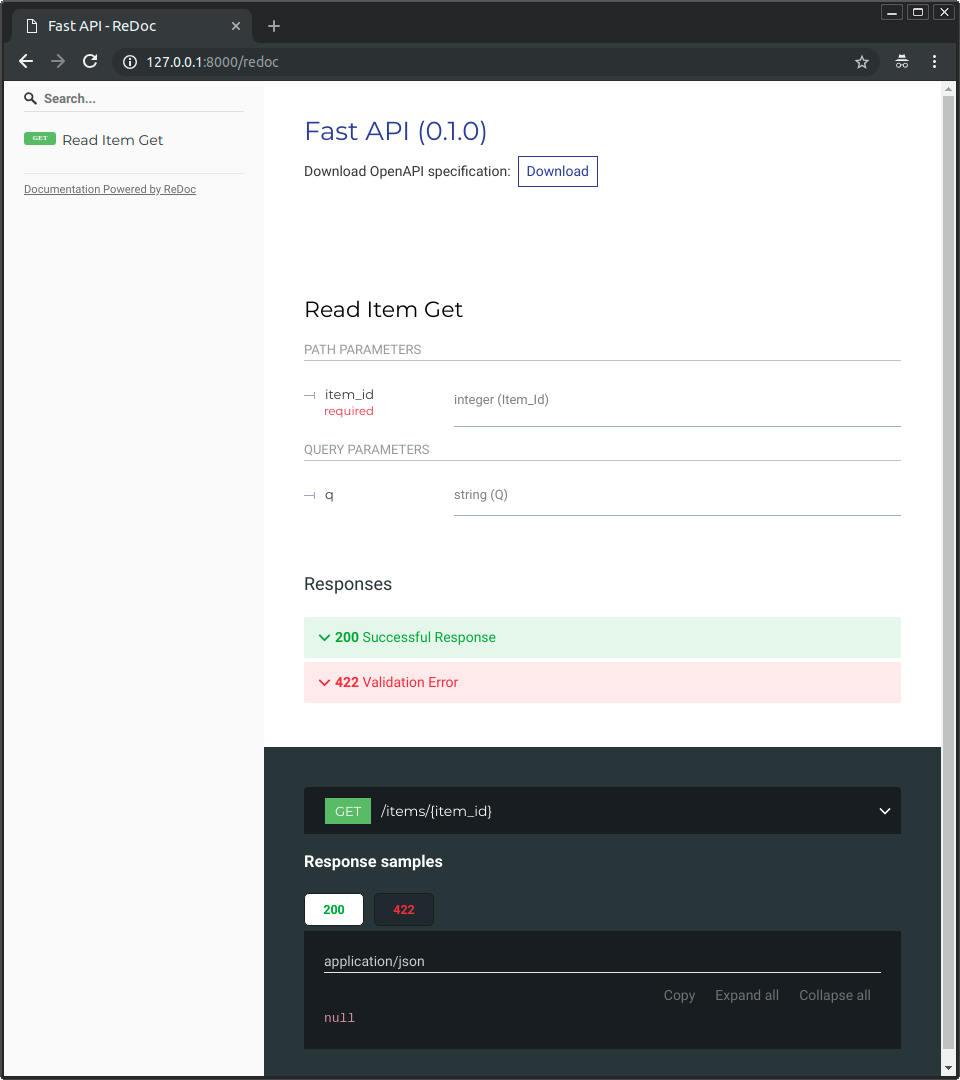- Sort Score
- Result 10 results
- Languages All
Results 151 - 160 of 226 for redeclare (0.13 sec)
-
docs/em/docs/features.md
🚥 👆 💪 2️⃣ ⏲ ↗️ ❔ ⚙️ 🐍 🆎 (🚥 👆 🚫 ⚙️ FastAPI), ✅ 📏 🔰: [🐍 🆎](python-types.md){.internal-link target=_blank}. 👆 ✍ 🐩 🐍 ⏮️ 🆎: ```Python from datetime import date from pydantic import BaseModel # Declare a variable as a str # and get editor support inside the function def main(user_id: str): return user_id # A Pydantic model class User(BaseModel): id: int name: str joined: date ```Registered: Sun Sep 07 07:19:17 UTC 2025 - Last Modified: Tue Aug 06 04:48:30 UTC 2024 - 8K bytes - Viewed (0) -
docs/pt/docs/tutorial/query-params-str-validations.md
# Parâmetros de consulta e validações de texto O **FastAPI** permite que você declare informações adicionais e validações aos seus parâmetros. Vamos utilizar essa aplicação como exemplo: {* ../../docs_src/query_params_str_validations/tutorial001.py hl[9] *} O parâmetro de consulta `q` é do tipo `Union[str, None]`, o que significa que é do tipo `str` mas que também pode ser `None`, e de fato, o valor padrão é `None`, então o FastAPI saberá que não é obrigatório.Registered: Sun Sep 07 07:19:17 UTC 2025 - Last Modified: Mon Nov 18 02:25:44 UTC 2024 - 9K bytes - Viewed (0) -
docs/fr/docs/tutorial/path-params-numeric-validations.md
{* ../../docs_src/path_params_numeric_validations/tutorial001_an_py310.py hl[10] *} /// note Un paramètre de chemin est toujours requis car il doit faire partie du chemin. Même si vous l'avez déclaré avec `None` ou défini une valeur par défaut, cela ne changerait rien, il serait toujours requis. /// ## Ordonnez les paramètres comme vous le souhaitez /// tipRegistered: Sun Sep 07 07:19:17 UTC 2025 - Last Modified: Sat Nov 09 16:39:20 UTC 2024 - 6.9K bytes - Viewed (0) -
docs/pt/docs/tutorial/body-nested-models.md
### Importe `List` do typing Primeiramente, importe `List` do módulo `typing` que já vem por padrão no Python: {* ../../docs_src/body_nested_models/tutorial002.py hl[1] *} ### Declare a `List` com um parâmetro de tipo Para declarar tipos que têm parâmetros de tipo(tipos internos), como `list`, `dict`, `tuple`: * Importe os do modulo `typing`Registered: Sun Sep 07 07:19:17 UTC 2025 - Last Modified: Mon Nov 18 02:25:44 UTC 2024 - 7.2K bytes - Viewed (0) -
guava-testlib/src/com/google/common/collect/testing/testers/NavigableSetNavigationTester.java
* FeatureSpecificTestSuiteBuilder.suppressing()}. */ /* * TODO(cpovirk): or we could make HOLES_FORBIDDEN a feature. Or we could declare that * implementations are permitted to throw IAE if a hole is requested, and we could update * test*Hole to permit IAE. (But might this ignore genuine bugs?) But see the TODO above
Registered: Fri Sep 05 12:43:10 UTC 2025 - Last Modified: Thu Nov 14 23:40:07 UTC 2024 - 8.5K bytes - Viewed (0) -
docs/pt/docs/tutorial/request_files.md
## Envio de Múltiplos Arquivos É possível enviar múltiplos arquivos ao mesmo tmepo. Ele ficam associados ao mesmo "campo do formulário" enviado com "form data". Para usar isso, declare uma lista de `bytes` ou `UploadFile`: {* ../../docs_src/request_files/tutorial002_an_py39.py hl[10,15] *} Você irá receber, como delcarado uma lista (`list`) de `bytes` ou `UploadFile`s,
Registered: Sun Sep 07 07:19:17 UTC 2025 - Last Modified: Mon Nov 18 02:25:44 UTC 2024 - 7.7K bytes - Viewed (0) -
android/guava-testlib/src/com/google/common/collect/testing/AbstractContainerTester.java
} /** * Returns the {@linkplain #getSampleElements() sample elements} as ordered by {@link * TestContainerGenerator#order(List)}. Tests should use this method only if they declare * requirement {@link com.google.common.collect.testing.features.CollectionFeature#KNOWN_ORDER}. */ protected List<E> getOrderedElements() { List<E> list = new ArrayList<>();Registered: Fri Sep 05 12:43:10 UTC 2025 - Last Modified: Sun Dec 22 03:38:46 UTC 2024 - 8.9K bytes - Viewed (0) -
docs/fr/docs/advanced/path-operation-advanced-configuration.md
Vous pouvez le faire avec `openapi_extra` : {* ../../docs_src/path_operation_advanced_configuration/tutorial006.py hl[20:37,39:40] *}Registered: Sun Sep 07 07:19:17 UTC 2025 - Last Modified: Sat Nov 09 16:39:20 UTC 2024 - 7.8K bytes - Viewed (0) -
docs/en/docs/tutorial/security/simple-oauth2.md
The form field name is `scope` (in singular), but it is actually a long string with "scopes" separated by spaces. Each "scope" is just a string (without spaces). They are normally used to declare specific security permissions, for example: * `users:read` or `users:write` are common examples. * `instagram_basic` is used by Facebook / Instagram. * `https://www.googleapis.com/auth/drive` is used by Google. /// info
Registered: Sun Sep 07 07:19:17 UTC 2025 - Last Modified: Sun Aug 31 09:15:41 UTC 2025 - 9.4K bytes - Viewed (0) -
README.md
 ## Example upgrade { #example-upgrade } Now modify the file `main.py` to receive a body from a `PUT` request. Declare the body using standard Python types, thanks to Pydantic. ```Python hl_lines="4 9-12 25-27" from typing import Union from fastapi import FastAPI from pydantic import BaseModel app = FastAPI()Registered: Sun Sep 07 07:19:17 UTC 2025 - Last Modified: Sun Aug 31 15:19:49 UTC 2025 - 24.3K bytes - Viewed (0)